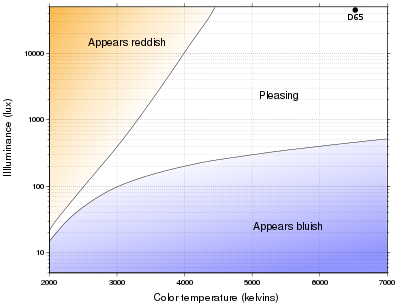
The Kruithof curve describes a region of illuminance levels and color temperatures that are often viewed as comfortable or pleasing to an observer. The curve was constructed from psychophysical data collected by Dutch physicist Arie Andries Kruithof,[2] though the original experimental data is not present on the curve itself. Lighting conditions within the bounded region were empirically assessed as being pleasing or natural, whereas conditions outside the region were considered uncomfortable, displeasing or unnatural.[3] The Kruithof curve is a sufficient model for describing sources that are considered natural or closely resemble Planckian black bodies, but its value in describing human preference has been consistently questioned by further studies on interior lighting.[4][5]
For example, natural daylight has a color temperature of 6500 K and an illuminance of about 104 to 105 lux. This color temperature–illuminance pair results in natural color rendition, but if viewed at a low illuminance, would appear bluish. At typical indoor office illuminance levels of about 400 lux, pleasing color temperatures are lower (between 3000 and 6000 K), and at typical home illuminance levels of about 75 lux, pleasing color temperatures are even lower (between 2400 and 2700 K). These color temperature-illuminance pairs are often achieved with fluorescent and incandescent sources, respectively. The pleasing region of the curve contains color temperatures and illuminance levels comparable to naturally lit environments.
- ^ Weintraub, Steven (September 2000). "The Color of White: Is there a "preferred" color temperature for the exhibition of works of art?". Western Association for Art Conservation Newsletter. 21 (3).
- ^ Kruithof, Arie Andries (December 12, 1934). "Aanslag van het waterstofmolecuulspectrum door electronen". Archived from the original on July 24, 2011. Retrieved May 6, 2008. (PhD dissertation at Utrecht University under Leonard Ornstein) (in Dutch)
- ^ Kruithof, Arie Andries (1941). "Tubular Luminescence Lamps for General Illumination". Philips Technical Review. 6 (3): 65–96. ISSN 0031-7926.
- ^ Cite error: The named reference
Davis & Ginthner 1990was invoked but never defined (see the help page). - ^ Cite error: The named reference
Boyce & Cuttle 1990was invoked but never defined (see the help page).